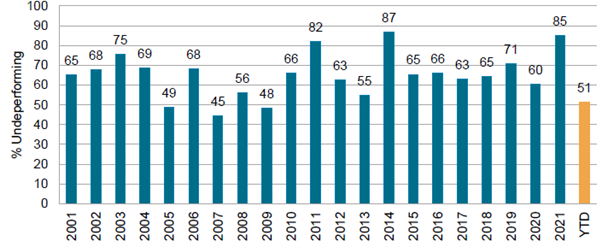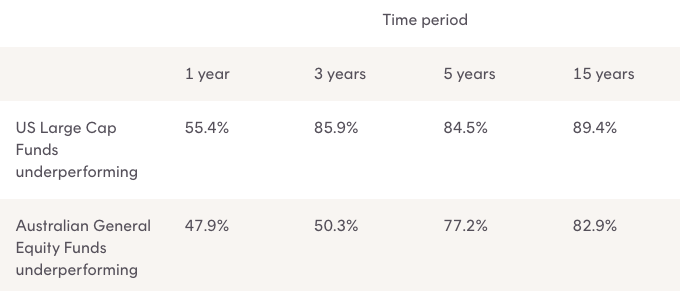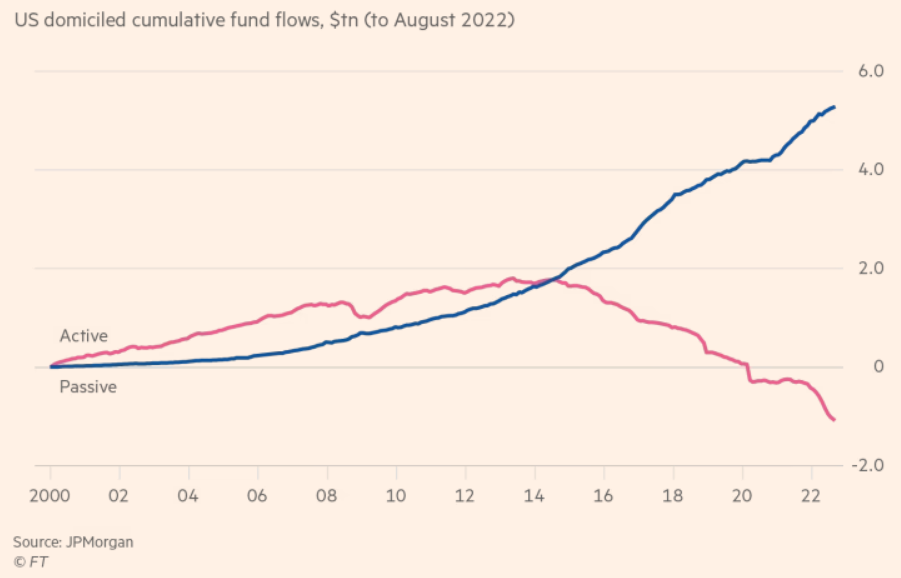The data is in, how active funds stack up against their benchmarks

Betashares
This article was written by Richard Montgomery
This year marks the 20-year anniversary of the SPIVA scorecard, the go-to report for investors and others interested in the ‘active vs. passive’ debate. With two decades of data to refer to, it’s timely to look at what we can learn from these reports.
What is SPIVA?
SPIVA stands for ‘S&P Indices versus Active’. The SPIVA reports are published by S&P Dow Jones Indices, a division of S&P Global. Their primary purpose is to inform the ‘active vs. passive’ debate, by providing data on how actively managed funds around the world have performed, over both the long and the short term, against appropriate benchmarks.
The two main reports that are produced are:
The SPIVA Scorecards – provide data on the performance of active funds against relevant benchmarks. Reports are provided for markets around the world, both equity markets and fixed income markets. They are broken down into categories according to the type of fund, to ensure the appropriate benchmark is used – for example, large, mid or small-cap funds.
The SPIVA Persistence Scorecards – measure the consistency of a fund’s performance relative to its peers. In other words – are funds that outperform in a given period able to maintain that outperformance in subsequent periods? This Scorecard is designed to address the question of whether outperformance is the result of skill (in which case outperformance would be expected to persist over time) or luck (in which case outperformance would be expected to be more random).
What do the results tell us?
The SPIVA data tells a remarkably consistent story.
According to Craig Lazzara, Managing Director, Core Product Management S&P Dow Jones Indices: “Our very first SPIVA Scorecard reported that most active managers had underperformed a benchmark appropriate to their investment style over a full market cycle. Our most recent SPIVA update reports more or less the same thing.”
The first SPIVA Report covered the US equity market only. The chart below shows the percentage of large-cap US equity funds underperforming the S&P 500 each year since then.
Percentage of Large-Cap Domestic Equity Funds Underperforming the S&P 500 Each Year

Since the first report, SPIVA has expanded to nine different geographies and now reports on the performance of over 100 different active fund categories around the world.
A consistent theme of SPIVA Scorecards over the years has been that underperformance rates generally rose with the length of the period in which performance was measured.
The table below shows the percentage of active Australian and US equity funds that have underperformed their relevant benchmark.
Percentage of US and Australian active funds underperforming the broad share market (to 30 June 2022)

Over a 15-year horizon, more than 70% of actively managed funds failed to outperform their comparison index in 38 out of the 39 categories of equity and fixed-income funds that SPIVA measures performance for.
Good luck or good management?
The disclaimer “Past performance is no guarantee of future performance” is included in material on all funds offered to investors (including our own). What this is basically telling potential investors is just because a fund, or fund manager, has produced good results in the past, this doesn’t necessarily mean they will do so in the future.
However, past performance tends to be one of the first things that potential investors look at when deciding whether to put their precious savings into an investment. Human nature is such that – while the lawyers are telling us not to count on it – we tend to be biased towards funds that have done well in the past.
With index tracking funds, there is no decision to be made around the ‘skill’ of the fund manager, as the manager is simply aiming to replicate the performance of the index (before fees and expenses). If the index does well, so too does the fund; if the index performs poorly so too does the fund.
This is not the case with the active fund manager, who typically aims to do better than the index – and in doing so, justify their active management fee.
For this exchange (fees charged for the fund manager’s skill) to be justified, any outperformance has to be the result of that ‘skill’, rather than luck. And if it is the result of skill, then that outperformance should persist over time. If it doesn’t, that indicates that chance is playing a part in the proceedings.
So – what does the data tell us?
The SPIVA Persistence Reports show the percentage of funds that remain in the top-quartile or top-half rankings over consecutive three- and five-year periods.
The mid-2022 US Persistence Report found that within each of the reported domestic equity categories, among all the funds whose performance placed them in the top quartile for the 12 months ending June 2020, the percentage of funds that managed to remain in the top quartile over the next two years was… zero. Not a single fund that was in the top 25% in the year ending 2020 remained there for the following two years.
The report also looked at the top 50% of domestic equity funds in the 12 months ending 30 June 2018, and their performance over the subsequent four years. It found that amongst all domestic equity funds, there was a 1% chance of a top-half performer, as of 30 June 2018, still being a top-half performer as of 30 June 2022. For perspective, if performance was randomly distributed (i.e. the chances of being in the top 50% were the result of a coin toss), that chance would be 6.25%.
Performance of top 50% of domestic US equity funds from 1 July 2018 to 30 June 2022

Source: S&P Dow Jones Indices LLC, CRSP. Data as of June 30, 2022. Chart is provided for illustrative purposes. Past performance is no guarantee of future results.
Turning to the Australian market, the Australia Persistence Scorecard (June 2022) showed that less than 10% of Australian equity funds in the top quartile as of 30 June 2020 remained there at 30 June 2022, while none of the funds in the International Equity, Bond or A-REIT categories remained there.

The conclusions, which SPIVA states are ‘robust across geographies’, include:
- Most institutional managers underperform most of the time.
- The tendency for underperformance typically rises as the observation period lengthens.
- When good performance does occur, it tends not to persist. Above-average past performance does not predict above-average future performance.
How do investors see the active/passive question?
It’s impossible to know how many investors are influenced by the data presented by SPIVA over the last two decades. However, what is unarguable is that investors are increasingly favouring passive exposures over active ones.
The chart below shows cumulative US fund flows from 2000 to August 2022 into active and passive funds. Since 2014/5, it’s clear that money has been pouring into passive funds.
.png)
For more detailed information about SPIVA and the Performance reports, please click here
Find out more
Betashares provide access to a wide range of market indices, asset classes and investment strategies, all of which can be bought or sold like any share on the ASX. For further information, click the contact button below, or visit our website here.
3 topics

Patrick is the Editorial Director at Betashares and a member of the Investment Strategy and Research Team. He has over 15 years of finance and financial media experience with past roles at Livewire, netwealth, Link Group, and others.
Expertise

Patrick is the Editorial Director at Betashares and a member of the Investment Strategy and Research Team. He has over 15 years of finance and financial media experience with past roles at Livewire, netwealth, Link Group, and others.
